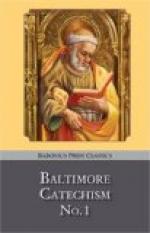Vested as described, when the candles have been lighted on the altar, the priest takes the covered chalice in his hand and goes to the altar, where, after arranging everything, he begins Mass. After saying many prayers, he uncovers the chalice, and the acolyte or altar boy brings up wine and water, and the priest puts some into the chalice. Then he says a prayer, and offers to God the bread and wine to be consecrated. This is called the offertory of the Mass, and takes place after the boy presents the wine and water. Immediately after the Sanctus the priest begins what is called the Canon of the Mass, and soon after comes to the time of consecration, and has before him on the paten the white bread, or host, and in the chalice wine. Remember, it is only bread and wine as yet. After saying some prayers the priest bends down over the altar and pronounces the words of consecration, namely, “This is My body,” over the bread; and “This is My blood,” over the wine. Then there is no longer the bread the priest brought out and the wine the boy gave, upon the altar, but instead of both the body and blood of Our Lord. After the words of consecration, the priest genuflects or kneels before the altar to adore Our Lord, who just came there at the words of consecration; he next holds up the body of Our Lord—the Host—for the people also to see and adore it; he then replaces it on the altar and again genuflects. He does just the same with the chalice. This is called the Elevation. The altar boy then rings the bell to call the people’s attention to it, for it is the most solemn part of the Mass. After more prayers the priest takes and consumes, that is, swallows, the sacred Host and drinks the precious blood from the chalice. Then the people come up to the altar to receive Holy Communion. But where does the priest get Holy Communion for them if he himself took all he consecrated? He opens the tabernacle, and there, in a large, beautiful vessel he has small Hosts. He consecrates a large number of these small hosts sometimes while he is consecrating the larger one for himself. When they are consecrated, he places them in the tabernacle, where they are kept with the sanctuary lamp burning before them, till at the different Masses they have all been given out to the people. Then he consecrates others at the next Mass, and does as before. The size of the Host does not make the slightest difference, as Our Lord is present whole and entire in the smallest particle of the Host. A little piece that you could scarcely see would be the body of Our Lord. However, the particle that is given to the people is about the size of a twenty-five-cent piece, so that they can swallow it before it melts. In receiving Holy Communion you must never let it entirely dissolve in your mouth, for if you do not swallow it you will not receive Holy Communion at all.




